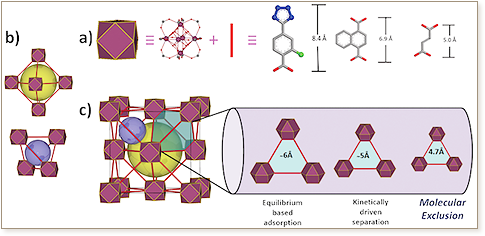

 Using isoreticular chemistry allows the design and construction of a new rare-earth metal (RE) fcu-MOF with a suitable aperture size for practical steric adsorptive separations. The judicious choice of a relatively short organic building block, namely fumarate, to bridge the 12-connected RE hexanuclear clusters has afforded the contraction of the well-defined RE-fcu-MOF triangular window aperture, the sole access to the two interconnected octahedral and tetrahedral cages. The newly constructed RE (Y3+ and Tb3+) fcu-MOF analogues display unprecedented total exclusion of branched paraffins from normal paraffins. The resultant window aperture size of about 4.7 Å, regarded as a sorbate-size cut-off, enabled a complete sieving of branched paraffins from normal paraffins. The results are supported by collective single gas and mixed gas/vapor adsorption and calorimetric studies.
Using isoreticular chemistry allows the design and construction of a new rare-earth metal (RE) fcu-MOF with a suitable aperture size for practical steric adsorptive separations. The judicious choice of a relatively short organic building block, namely fumarate, to bridge the 12-connected RE hexanuclear clusters has afforded the contraction of the well-defined RE-fcu-MOF triangular window aperture, the sole access to the two interconnected octahedral and tetrahedral cages. The newly constructed RE (Y3+ and Tb3+) fcu-MOF analogues display unprecedented total exclusion of branched paraffins from normal paraffins. The resultant window aperture size of about 4.7 Å, regarded as a sorbate-size cut-off, enabled a complete sieving of branched paraffins from normal paraffins. The results are supported by collective single gas and mixed gas/vapor adsorption and calorimetric studies.